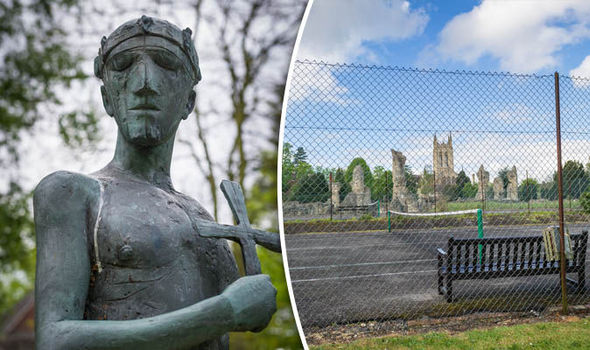Plans for a tennis court to be dug up to search for remains of Saxon King.
Saint Edmund is believed to have been killed by the Vikings in the 9th century after refusing to denounce his Christianity.
His remains were kept in a shrine in Bury St Edmunds but were later lost during Henry VIII’s reign and the desecration of the Benedictine Abbey.
Now, Bury St Edmunds Believe it might have the remains of Saint Edmund, a Saxon monarch, buried under one of his tennis courts.

At the time of the desecration of the Benedictine Abbey, during Henry VIII’s reign, the remains were lost.
But historians believe the remains may well be below the tennis courts in Abbey Gardens, which sit on top of a former monks’ graveyard in the sedate East Anglian town.
Plans to move the courts are being considered so archaeologists may soon be allowed to look for King Edmund’s remains underneath.
The plans have the backing of St Edmundsbury Borough Council, who own the Abbey Gardens, near St Edmundsbury Cathedral.
Robert Everitt, the local councillor in charge of the project said: “It would be an incredibly important historical discovery if he was found under there.
“It is something the borough want to do and the cathedral are in agreement as well, but we need to ensure we replace the courts.
“We are looking at St James Middle School courts, which are not being used [as the school is closed]. They would be ideal and would ensure people can play tennis right next to Abbey Gardens.”
Academic researcher and historian Francis Young, who was born in Bury, said: “The commissioners who dissolved the Abbey on November 4, 1539, mentioned nothing about the body, and given St Edmund’s royal status it is likely they would have quietly allowed the monks to remove the body from the shrine and relocate it.
“According to a third-hand account from 1697, St Edmund was placed in an iron chest by a few monks but sadly the account does not give the location within the Abbey precincts where he was buried. On balance, however, the monks’ cemetery is the most likely location.”

If the monks did use an iron chest it would help archaeologists distinguish the monks’ graves from that of the king. A heritage partnership is tasked with preserving and promoting the Abbey ruins, with the removal of the courts aimed at improving the experience for visitors.
Edmund was the King of the East Angles in the 9th Century. It is widely accepted that Edmund was killed by Vikings. It is thought his place of death was somewhere in Suffolk or Norfolk.
His myth tells of brave King Edmund refusing to denounce his Christianity and being killed by several arrows. The Vikings then removed his head so Edmund could not be buried whole. However, loyal followers were able to find his head after a wolf called to them, shouting “here, here, here”.
Shortly after his death, a shrine containing his remains was built in the Abbey in a town called Bedericesworth.
This town later became Bury St Edmunds and the most popular and famous pilgrimage in England, visited by many kings. Saint Edmund later became the Patron Saint of England.
The Abbey was desecrated in the 16th Century when his remains are believed to have been removed from the shrine.
